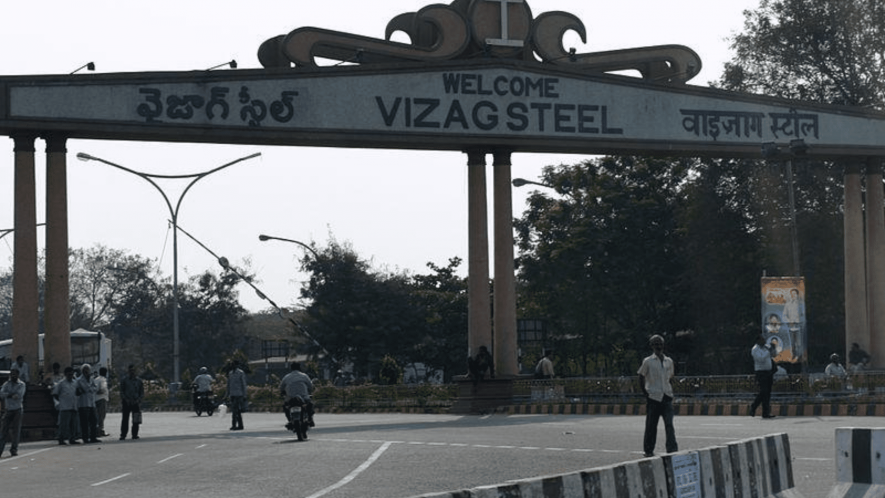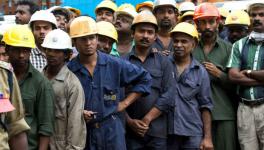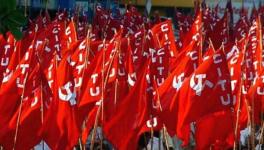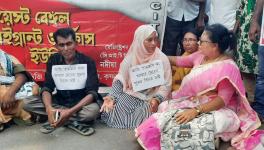‘Worker Resistance’ Foiled Attempts to Privatise Vizag Steel Plant

Image Courtesy: Wikipedia
As the 17th All India CITU conference concluded in Bengaluru on Sunday, delegates started returning to their hotels to prepare for the journey home. Among them were union leaders of the Vizag Steel Plant, also known as Rashtriya Ispat Nigam Limited (RINL). The factory’s workers have been protesting privatisation for 710 days.
Newsclick caught up with CH Narasinga Rao (70), CITU state general secretary and chairman of the Visakha Ukku Parirakshana Porata Committee (VUPPC), at the Moti Mahal Hotel, Gandhinagar. He spoke about how the workers have resisted the 100% privatisation of the plant.
When did the Vizag Steel Plant start operations?
The plant started operations in 1987. Though the foundation stone was laid by Indira Gandhi in 1971, funds hadn’t been allocated to the project. During the Janata Party government, Rs 1,000 crore was allotted in the Budget, and the construction started. The project was not conceived by the government alone; there was a huge struggle for it. Schools and colleges were closed for several months in 1966. This culminated in a police firing on protestors. In total, 32 people died during the protests. Four years later, the plant was sanctioned by the government.
What was the reason for the struggle?
People expected that industrialisation will create jobs. There were four steel plants: Bhilai, Bokaro, Durgapur and Rourkela. All were in north India. The government announced that the fifth one would be set up in Andhra Pradesh but did not sanction funds for construction. So, the people fought for the project.
Vizag had a port and the other plants were located close to mines. Research showed that the transportation of heavy metals is cheaper by sea. Even today, it is the only steel plant in India located in a port city.
The agitations continued for one year (1966) and spread throughout the state. The police firing happened in Warangal, Hyderabad and Vizag. In 1967, general elections were held, but the project was still not announced. In 1971, Congress (under Indira Gandhi) was growing apprehensive about the ‘syndicate’ (a political faction within Congress) and announced the project.
When did the agitation against privatisation start?
There have been attempts to privatise the plant since the 1991 economic liberalisation. The government tried to divide some departments and lend the assets to private players. It tried to partly privatise departments like the thermal plant, oxygen plant, steel melting shop, etc—but never the entire plant.
On January 27, 2021, the government released a notification about the ‘strategic sale’. This was the first time a government signalled its intention to sell 100% of its stake in the plant. Immediately, we started a protest and put up a pandal with hundreds of workers starting a hunger strike in shifts. A team was scheduled to visit Vizag in November 2021 to start the valuation of assets. We prevented them from entering the plant. The hunger strike has been continuing for the last two years.
The government partly divested its stake (3.5%) in the Life Insurance Corporation of India (LIC) by going for an IPO. It has divested some portions in BPCL, HPCL, ONGC and many other public sector companies. But because of our struggle, the government still holds a 100% stake in the Vizag Steel Plant.
Have there been any strikes?
We were on strike for three days. Solidarity events were held throughout the state with CITU holding conferences in every district. We pressured the state government to pass a resolution in the Assembly opposing the ‘strategic sale’. Even during the strikes, we ensured that the temperature in the blast furnaces was under control. If the blast furnace melts, nobody can open it again. It will result in a loss of thousands of crores. We take care of the plant even during strikes.
This is a highly skilled job.
Yes. The workers are trained at it is and polytechnics and many of them have engineering degrees.
How many workers are employed at the plant?
There are 16,000 permanent workers and 14,000 contractual. When older workers retire, the management does not replace them. Therefore, the workload on current workers is increasing. Despite this, production hasn’t dropped. But now, the government is trying to paralyse the plant’s functioning. Blast furnace number 3 has been closed. It is an important department in the smelting process.
Could you elaborate on the struggle committee?
The committee has 23 associations of permanent and contractual workers. We formed it as soon as the government released the notification. In Telugu, it is called Visakha Ukku Parirakshana Porata Committee. The three largest unions are CITU, AITUC and INTUC.
Who was in line to purchase the plant?
South Korean steel company POSCO had signed an MoU with the government to take over the land belonging to the plant. POSCO’s Indian partner is very close to the Central government.
Could you speak a little about your background?
I completed my BL (bachelor of law) from Andhra University in 1978. Six of my classmates are High Court Judges. Another colleague of mine, K Yerran Naidu, became a Cabinet minister.
After graduation, I dedicated my life to CITU. From the construction of the Vizag Steel Plant till today, I have been a part of the union. In total, 40,000 contract workers were brought in to construct the plant. We had to fight with the management several times to ensure that the workers received their entitlements. In those days, labour regulations were not followed. But workers were united during important issues even if they did not directly affect them.
There is a 100-bed hospital attached to the plant. There were attempts to privatise it, but we resisted. Now, POSCO is trying to take over our plant. It is one of the worst companies I have ever come across. No other company in the steel industry has been automated to this level. While we have 20-tonne trucks, POSCO uses 100-tonne driverless trucks. It runs a steel plant in South Korea with an annual output of 20 million tonnes with 4,000 workers. At the Vizag plant, the annual output is 7 million tonnes with an employee strength of 30,000.
How crucial is the plant for Vizag’s economy?
This is one of the largest employers in the region. In FY 2021-22, it had an annual turnover of Rs 28,000 crore and a net profit of Rs 1,900 crore. This is national wealth. How can anyone think of selling it?
In the last three years, steel companies have announced huge profits.
There is a reason for this. In the last three years, the government changed the rule for companies that owned captive mines. Earlier, they were supposed to exclusively use iron ore for their own production needs. Now, companies with captive mines can sell 10% of iron ore in the open market. Only the Vizag plant missed out because we don’t have our mine. During the CITU conference, the federation on steel presented a report on the sector. Besides the Vizag plant, the government has tried to put up other plants for ‘strategic sale’—at Salem (SAIL), Bhadravati (VISL) and Durgapur (IISCO). However, due to worker resistance, the process has stopped. Another issue faced by the workers is no wage revision. In other steel companies, wages were revised in February 2022. At the Vizag plant, wages haven’t been revised for 10 years.
Get the latest reports & analysis with people's perspective on Protests, movements & deep analytical videos, discussions of the current affairs in your Telegram app. Subscribe to NewsClick's Telegram channel & get Real-Time updates on stories, as they get published on our website.
























